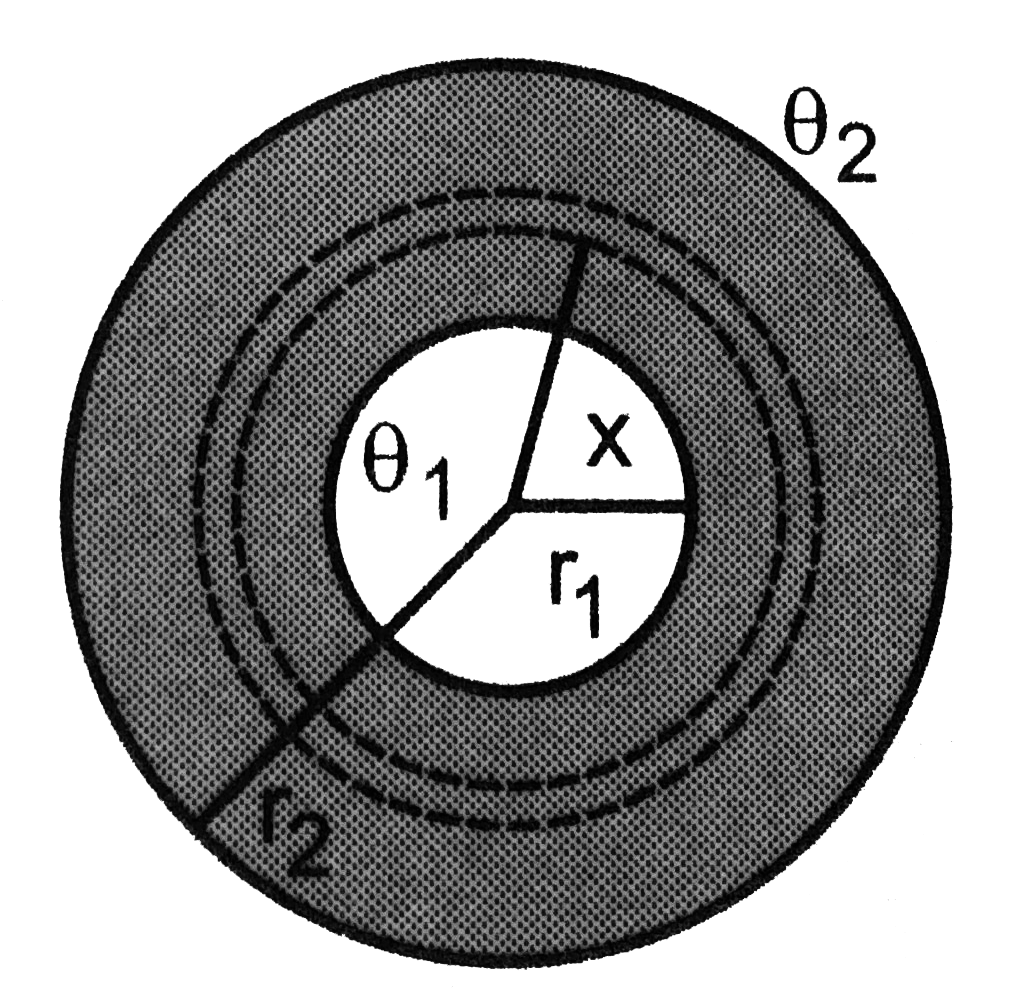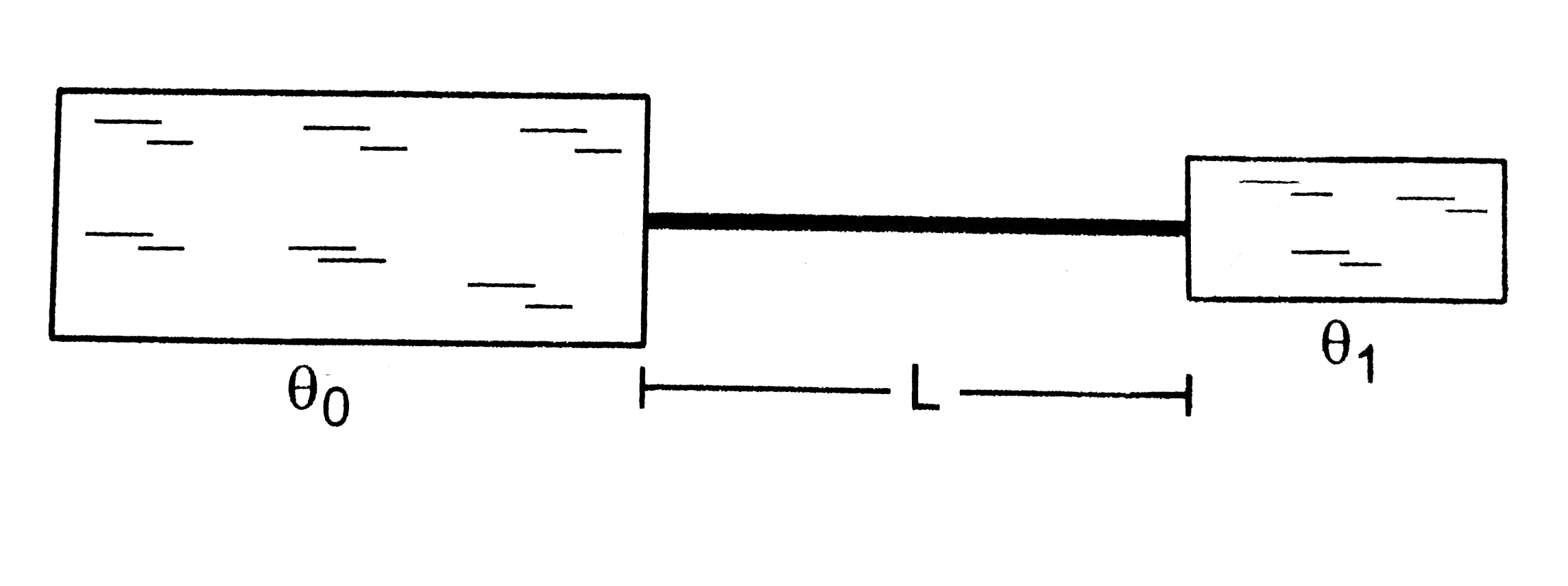Two liquids of specific heat ratio 1:2 are at temperature 2θandθ
if equal amounts of them are mixed, then temperature of mixture is 1.5θ
if equal amounts of them are mixed, then temperature of mixture is 43θ
for their equal amounts, the ratio of heat capacities is 1:1
for their equal amounts, the ratio of their heat capacities is 1:2.
The correct Answer is:B, D
To solve the problem, we need to find the temperature of the mixture when two liquids with specific heat ratios of 1:2 are mixed, and then determine the ratio of their heat capacities.
1. Identify the Given Information:
- Liquid 1 is at temperature 2θ.
- Liquid 2 is at temperature θ.
- The specific heat ratio S1S2=12.
2. Assume Mass and Specific Heat:
- Let the mass of each liquid be M.
- Let the specific heat of liquid 1 be S1 and that of liquid 2 be S2.
- From the ratio, we have S1=k and S2=2k for some constant k.
3. Set Up the Heat Transfer Equation:
- When the two liquids are mixed, the heat lost by liquid 1 must equal the heat gained by liquid 2.
- Heat lost by liquid 1:
Q1=M⋅S1⋅(2θ−T)
- Heat gained by liquid 2:
Q2=M⋅S2⋅(T−θ)
4. Equate Heat Loss and Gain:
M⋅S1⋅(2θ−T)=M⋅S2⋅(T−θ)
- The mass M cancels out from both sides.
5. Substitute the Specific Heats:
S1⋅(2θ−T)=S2⋅(T−θ)
- Substitute S1=k and S2=2k:
k(2θ−T)=2k(T−θ)
6. Simplify the Equation:
- Dividing both sides by k (assuming k≠0):
2θ−T=2(T−θ)
- Expanding the right side:
2θ−T=2T−2θ
7. Rearranging the Equation:
- Move all terms involving T to one side:
2θ+2θ=2T+T
- This simplifies to:
4θ=3T
8. Solve for T:
T=4θ3
9. Find the Ratio of Heat Capacities:
- Heat capacity H1 of liquid 1:
H1=M⋅S1
- Heat capacity H2 of liquid 2:
H2=M⋅S2
- The ratio of heat capacities:
H1H2=S1S2=12
Final Answers:
- The temperature of the mixture T=4θ3.
- The ratio of heat capacities H1:H2=1:2.
- Liquid 1 is at temperature 2θ.
- Liquid 2 is at temperature θ.
- The specific heat ratio S1S2=12.
- Let the mass of each liquid be M.
- Let the specific heat of liquid 1 be S1 and that of liquid 2 be S2.
- From the ratio, we have S1=k and S2=2k for some constant k.
- When the two liquids are mixed, the heat lost by liquid 1 must equal the heat gained by liquid 2.
- Heat lost by liquid 1:
Q1=M⋅S1⋅(2θ−T)
- Heat gained by liquid 2:
Q2=M⋅S2⋅(T−θ)
M⋅S1⋅(2θ−T)=M⋅S2⋅(T−θ)
- The mass M cancels out from both sides.
S1⋅(2θ−T)=S2⋅(T−θ)
- Substitute S1=k and S2=2k:
k(2θ−T)=2k(T−θ)
- Dividing both sides by k (assuming k≠0):
2θ−T=2(T−θ)
- Expanding the right side:
2θ−T=2T−2θ
- Move all terms involving T to one side:
2θ+2θ=2T+T
- This simplifies to:
4θ=3T
T=4θ3
- Heat capacity H1 of liquid 1:
H1=M⋅S1
- Heat capacity H2 of liquid 2:
H2=M⋅S2
- The ratio of heat capacities:
H1H2=S1S2=12
- The temperature of the mixture T=4θ3.
- The ratio of heat capacities H1:H2=1:2.
Topper's Solved these Questions
- CALORIMETRY & HEAT TRANSFERBOOK - DC PANDEY ENGLISHCHAPTER - CALORIMETRY & HEAT TRANSFEREXERCISE - Level 2 Subjective
14 Videos
- CALORIMETRY & HEAT TRANSFERBOOK - DC PANDEY ENGLISHCHAPTER - CALORIMETRY & HEAT TRANSFEREXERCISE - Level 2 Single Correct
7 Videos
- BASIC MATHEMATICSBOOK - DC PANDEY ENGLISHCHAPTER - BASIC MATHEMATICSEXERCISE - Exercise
13 Videos
- CALORIMETRY AND HEAT TRANSFERBOOK - DC PANDEY ENGLISHCHAPTER - CALORIMETRY AND HEAT TRANSFEREXERCISE - Medical entrance s gallery
38 Videos
Similar Questions
A liquid of mass m and specific heat c is heated to a temperature 2T. Another liquid of mass m/2 and specific heat 2 c is heated to a temperature T. If these two liquids are mixed, the resulting temperature of the mixture is
View SolutionThe ends of a metal rod are kept at temperatures θ1 and θ2 with θ2>θ1. The rate of flow of heat along the rod is directly proportional to
View SolutionThe ends of a metal rod are kept at temperature θ1andθ2 with θ2>θ1. At steady state the rate of flow of heat along the rod is directly proportional to
View SolutionTwo identical rods are made of different materials whose thermal conductivities are K1andK2. They are placed end to end between two heat reservoirs at temperatures θ1andθ2. The temperature of the junction of the rod is

View SolutionIf three different liquid of different masses specific heats and temperature are mixed with each other and then what is the temperature mixture at thermal equilibrium.
m1,s1,T1→ specification for liquid
m2,s2,T2→specification for liquid.
m3,s3,T3→ specification for liquid.
View SolutionA liquid in a beaker has temperature θ(t) at time t and θ0 is temperature of surroundings, then according to Newton's law of cooling the correct graph between loge(θ−θ0) and t is :
View SolutionTwo thin metallic spherical shells of radii r1 and r2 (r1<r2) are placed with their centres coinciding. A material of thermal conductivity K is filled in the space between the shells. The inner shells is maintained at temperature θ1 .and the outer shell at temperature θ2 (θ1<θ2). Calculate the rate at which heat flows radially through the material.

View SolutionShow, with the help of a labelled graph, how thermo emf .e. developed by a thermocouple varies with θ, the temperature difference between the two junctions. On the graph, mark neutral temperature as θN and temperature of inversion as θ1.
View SolutionTwo spheres A and B have diameters in the ratio 1:2, densities in the ratio 2:1 and specific heat in the ratio 1:3. Find the ratio of their thermal capacities.
View SolutionFigure shows a large tank of water at a constant temperature θ0 and a small vessel containing a mass m of water at an initial temperature θ1(<θ0). A metal rod of length L, area of cross section A and thermal conductivity K connects the two vessels. Find the time taken for the temperature of the water in the smaller vessel to become θ2(θ1<θ2<θ0) . Specific heat capacity of water is s and all other heat capacities are negligible.

View Solution
